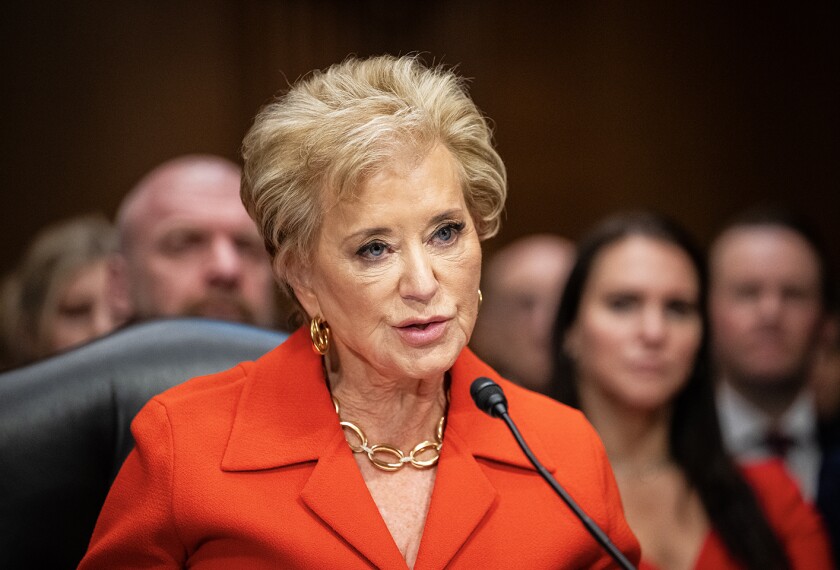Federally funded education research is in a state of flux, and that’s certainly an understatement as the U.S. Department of Education has canceled nearly a billion dollars worth of research contracts.
What does this mean for schools, and how should researchers respond?
Don’t ‘Surrender’
Morgan Polikoff, Ph.D., is a professor at the University of Southern California Rossier School of Education and a director of the USC EdPolicy Hub:
“What’s the resistance strategy? How do we shut it down? I’m just so at a loss.”
This was a message I received from a friend—an assistant professor at another institution who’s suddenly lost access to federal data, had a student’s job offer rescinded, and expects to lose out on a federal grant opportunity.
What’s happened in the last week has been breathtaking in its speed and potential impact. Last Friday, the Trump administration NIH’s (National Institutes of Health) “indirect rates” that the federal government pays universities to cover the building-related and administrative costs of doing research. I described this seemingly arcane decision as a “” because it immediately—overnight—costs the most productive universities hundreds of million dollars each, assuming the change is not rescinded. And even though relatively few educational researchers are substantially funded by NIH, these cuts will be shared across the university.
Then on Monday, DOGE took its chainsaw to the Department of Education, in critical research contracts on topics like COVID recovery, absenteeism, and student mental health. Beyond this, grant programs at the department are up in the air, as no one even knows if federal granting will continue and in what form. fund critical research on every major issue in schools, and they train the next generation of educational researchers and leaders to work together in research-practice partnerships to address districts’ pressing needs.
Why should K-12 educators care about these issues? University schools of education were already struggling under the weight of enrollment declines and relentless attacks from politicians; the layoffs to come could seriously impact course and program availability. Besides that, many K-12 districts have partnerships funded by federal grants or have folks working in their district offices who were trained under them—the abrupt changes could seriously harm research and data support inside school districts as well. Most importantly, research done by university staff with schools and districts has historically provided insights into what works, or what may work, in classrooms under what circumstances. Without it, or with it at greatly reduced levels, K-12 educators will be left with less support in dealing with what may be increasing classroom challenges.
How should researchers think about the current moment, and what should they do to help each other and K-12 educators? Here is how I am approaching the situation.
Protect yourself. Many of us are in the field specifically because we want to help other people (especially children but also educators), and in this moment, we have an impulse to protect everyone. And of course, if you safely can, you should. But you need to be smart about making choices that might put you in harm’s way—if you put yourself out of commission, you can’t help anyone else, either. Now is not the time to take bold risks that put you in the cross hairs. One can continue the fight for justice in education without getting oneself fired.

Speak clearly about what’s happening. At the same time, one can, and should, speak clearly to the public about what’s happening to education research and why it matters. The general public doesn’t understand education research, and often, researchers communicate in ways that don’t help the problem. Whether it’s talking to friends or family members, posting on social media, or writing commentaries/blogs/op-eds, it’s important to widely share your expertise and explain why the Trump administration’s actions are likely to be harmful.
Here, I recommend focusing on things that appeal to folks across the political spectrum. These actions harm our economy. They waste taxpayer dollars. They make it harder for teachers to do their jobs. Those sorts of arguments are likely to resonate.
Be nimble in your research focus. Though the federal funding picture will be bleak, there are always opportunities from foundations, and it’s good to be responsive to both the current funding conditions and to the issues that are most salient in schools. Federal data sources are great, but it can be even more rewarding and impactful to build partnerships with states and districts to help them with their challenges. If it’s hard to collect new data, that can mean it’s a good time to think about translation—working on other forms of writing that bring your important research to new audiences.
In my case, I’m thinking about how the book I’ve been planning to write—focused on a common-sense, evidence-informed policy agenda—can be made more relevant and timely in the current political context.
- Focus on what you can control. You don’t have to watch the news or be on Bluesky. You don’t have to fret about the state of the world. It’s good to focus on what you can control—the work you can do, the impact you can make. In times when things in the world are looking grim, you can still have an impact in your own corner of the world—on the colleagues you work with, the students you teach or supervise, the policymakers and educators you support. It’s important to find ways to contribute in whatever way makes you feel efficacious.
We’re only three weeks into what will be a very long four years (if not longer). It’s important that the education research community not surrender in the face of what’s ahead but rather find ways to work hard—in whatever ways we individually can—to continue to support better education for children.

Thanks to Morgan for contributing his thoughts.







